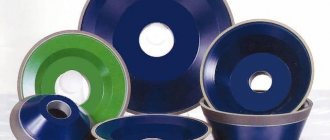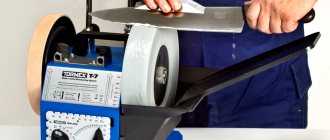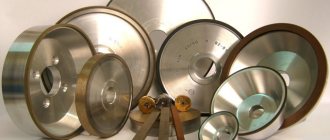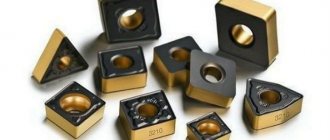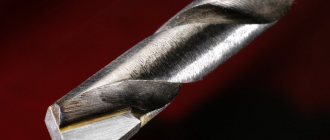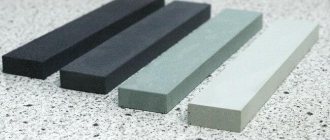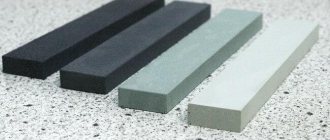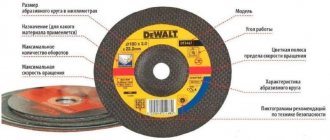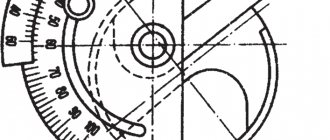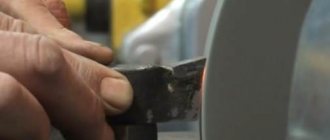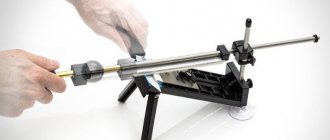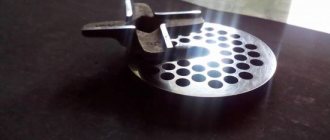The cutting tool becomes dull during operation. This is a natural process. The quality of the metal of the cutter or saw can only affect the rate of wear, but in any case, sharpening cannot be avoided. It is for this procedure that there are special diamond grinding wheels. They are mounted on a sharpening machine or angle grinder.
The designs of sharpening discs are different, for example, there is a diamond plate, a tool in the form of a cup, just a flat disc or any other shape. All this variety of configurations is due to the goal of making it convenient to grind or sharpen various tools.
Diamond wheels are most in demand for sharpening circular saws. They are designed to work with hard pobedite tips, which are difficult for a conventional sharpening tool to handle. Let's try to understand the questions of how diamond wheels are structured, what they are, and what exactly this or that type of product is intended for.
Types of Diamond Sharpening Blades
Diamond wheels for sharpening tools have their own classification. Abrasive tool manufacturing plants produce diamond discs in three shapes:
- In the form of a cup, it is a hollow cone inside with a metal base and a layer of diamond chips sprayed onto the working part.
- Like a plate, where there is one-sided or two-sided recess, the profile looks semicircular-convex.
- Discs with straight profile.
In addition, there are two main groups of tools, each of which uses a different diamond material for sharpening:
- An abrasive made from individually created diamonds, which is characterized by high grain uniformity.
- An abrasive made from natural diamond crystals, which are classified as technical.
And one of the most important categories that determines the purpose of a diamond disc for tool processing is the category based on the size of the bulk of the grain in the sprayed layer:
- A fine fraction of abrasive diamond used for grinding, finishing and finishing work on material processing (100/80).
- Medium abrasive diamond fraction used for targeted sharpening tasks, as well as for finishing grinding operations (125/100).
- A large fraction of abrasive diamond used in rough grinding or rough abrasion of the material being processed (200/160–160/125).
In addition to all of the above, when choosing a diamond disc for a specific grinding machine, you need to take into account the diameter of the seat, the width of the working surface of the abrasive, and the base material of the tool.
2 Device for sharpening turning tools
Sharpening tools involves not only wheels, but also the use of additional devices - boring machines.
Jig boring machines bore, drill, countersink, cut internal and external threads, grind cylindrical surfaces and trim ends.
Tool sharpening machine
A distinctive feature of the machines is a horizontal (or vertical) spindle, which makes axial feed movements. The necessary tool is fixed into the spindle hole - a boring bar with a cutter, a reamer, a drill, a milling cutter, etc.
- horizontal boring;
- coordinate boring;
- diamond boring;
- vertical boring.
Specialized models of jig boring machines:
- Jig boring machine 2D450.
- Jig boring machine 2V440A.
- Jig boring machine 2431.
- Jig boring machine 2421.
2.1 Sharpening technology
- Main back surface.
- Auxiliary back surface.
- Front surface.
- The radius of curvature of the ring.
At the end, the sharpening angles are checked using a template.
Types of sharpening of cutters
To obtain an even and smooth edge, the tool must be constantly in motion along the grinding surface. With this kind of work, the circles will last longer.
The tool can be processed dry or with water. The flow of water must be sufficient and continuous. A dry tool should not be immersed in water, as this may cause destruction of the working edge.
- fine-grained whetstone (technical oil is also used);
- copper wheel (boron carbide paste and technical oil are also used).
Finishing can only be done on cutting tools (edge width up to 3mm).
2.2 Safety precautions
- Do not use grinding wheels whose operation is accompanied by beating.
- The tool rest should be securely fixed closer to the circle.
- Use a tool rest to support the cutter.
- Do not press the cutter too hard (uneven heating can cause cracks; under high pressure the wheel can quickly deteriorate).
- Do not sharpen without a protective guard.
- Wear safety glasses.
- The workplace must have local ventilation.
2.3 Diamond wheel for sharpening tools (video)
The effectiveness of a cutting device depends on the quality and timeliness of sharpening. The latter is due to the fact that with constant use, functional resources are lost over time. Experience over the past decade has shown that the best abrasive tool for this job is diamond sharpening wheels. They process all known types of materials, and product wear is ten times less.
Design of diamond wheels for tool sharpening
Diamond grinding discs are round-shaped products with a metal base and a coating of diamond powder applied to it, which is fixed to the metal with a binder, and there is also a filler.
The disc brand is characterized by:
- the configuration of the body and the type of material from which it is made;
- circumference size;
- the concentration of abrasive grains;
- diamond fraction;
- the type of substance used as a binder;
- degree of accuracy;
- class of imbalance.
One of the important parameters is the wear resistance of the disc.
The bodies of diamond grinding wheels can be made of steel blanks, grades St-25, 30, 20 or 3, or aluminum alloys AK-6 or D-16, or polymer materials. For some grinding wheels of type A1PP, AGC, shanks are also made from steel grades U7 and U8.
As for the binders used, which hold the diamond grains together into a single form, discs are produced based on:
- Metallic bonds based on aluminum, copper, zinc or tin. The marking of such products indicates the letter M.
- Ceramic bundles based on fireclay or glass, to which an aluminum component is added. The marking here will contain the letter K.
- Organic-based binders are pulverbakelite and carbolite substances. The presence of such a link is indicated in the marking code by the letters KB.
Electrocorundum, graphite powder, copper, boron carbide and alumina are used as fillers.
Types of grain size depending on the type of processing
Grit size refers to the size of the bulk of grains among the total number of diamond particles in the abrasive.
The grain size is usually determined by three parameters: height, width and thickness, but in practice the width is taken as the basis. The surface finish of the material depends on the grain size of the sharpening wheel. This parameter also affects the efficiency of the work, the amount of metal that can be removed in one pass of the tool over the workpiece, and the wear of the working area of the diamond blade for sharpening. According to the international standardization standards FEPA, the marking of a diamond sharpening tool must contain a grit code: a combination of the letter F and a certain number following it. An increasing number indicates the presence of finer grains in the abrasive. To choose the right wheel for sharpening, you need to know the grade of material, what roughness you need to achieve in the end, and the allowable allowance.
There is an inversely proportional relationship between the grain size in the abrasive and the cleanliness of the metal surface after processing. Therefore, for finishing work, grinding wheels with the smallest diamond grains are used.
The most correct approach to processing and sharpening a tool lies in the sequential use of diamond wheels, starting with the rougher ones and ending with the finishing ones. The use of only the latter can lead to burning of the treated surface, clogging and rapid failure of the grinding wheel.
Based on the size of the grain fraction, it can be classified as one or another type of grain size:
- 100/80 – fine diamond grains. They are used to perform final finishing of thin blades, sharpening of metalworking cutters, and finishing grinding operations.
- 125/100 – medium diamond grains. Sharpening products to the required sharpness.
- 160/125 – large.
- 200/160 – very large diamond grains. Abrasives are suitable for smoothing the surface of a cutting tool.
Selecting an abrasive wheel
To choose the right abrasive tool, you need to know well the capabilities of the sharpening machine - power, operating speed, and the ability to adjust them. Also, for different types of surfaces to be treated, the appropriate type of sandpaper should be selected.
It is also necessary to know whether the operation requires cooling and lubrication of the working surface of the grinding wheel. If the abrasive manufacturer's requirements are not met, the sanding wheel itself can quickly be damaged and the workpiece can be damaged. It is important to choose the correct grit size of the abrasive wheel.
Surface treatment should begin with coarse grains, gradually moving to fine polishing with fine-grained sandpaper. By choosing the right tool, you can achieve high quality processing without even being a professional.
- For processing metals other than carbide, composite materials, as well as for sharpening household cutting tools Electrocorundum wheels are suitable. For ease of selection, they come in white, orange or blue. The low hardness of the abrasive, combined with the low strength of the bond, allows you to work with soft materials without fear of overheating and scaling.
The quality of polishing and sharpening is high. Used for finishing materials. Disadvantages include rapid wear and loss of surface shape due to uneven use (appearance of grooves, rounding of corners). - Abrasive wheels made of silicon carbide are used for primary (roughing) processing, removal of irregularities, processing of welds and sharpening of tools made of hard alloys. They have a distinct green color. Such abrasives are wear-resistant and retain their original shape well.
When working with hard materials, grooves do not form on them. Ideal for sharpening working carbide teeth of circular saws, drills, including pobedit bits. The disadvantage of such circles is high heating during operation. In some cases, it is necessary to supply a cooling emulsion to the work area. - For final polishing and removal of burrs from working with corundum and silicon carbide abrasives, vulcanite-based abrasive wheels are used. In fact, this is not emery - but a polishing disc, harder than felt. Made from vulcanized rubber with the addition of fine-grained abrasive. As a rule, electrocorundum sand. The tool is specific and is not suitable for changing the shape of a workpiece. But with its help you can perfectly smooth the surface being treated. After treatment with a vulcanite wheel, the surface quality can only be improved with the help of felt and GOI paste.
Read also: Accuracy class for commercial electricity metering
How to choose a grinding wheel, review of markings - video
Features of circles on organic bonds
All organic bonds cannot do without filler.
They have weak hardness, resistance to elevated temperatures and conduct heat poorly, but they are characterized by good productivity and high speed of tool sharpening operations. Diamond blades based on an organic component are purposefully used in finishing operations and when performing finishing work. They do an excellent job of sharpening pobedite materials, hard-component alloys, any metals and materials with super-hard structures. Bring the surface to be treated to levels 12 and 11 of roughness class. Discs are less susceptible to greasing, but wear out very quickly.
Profiles on ceramic bonds
Diamond-nickel coating is used in ceramic bonds.
This coating can be single-layer or can be applied in several layers. The thickness of the ceramic-based binder does not exceed 2/3 the size of diamond grains. Due to the fact that there is a free gap between the tops of the crystals and the bond, chips removed from the surface being processed are automatically removed without creating additional obstacles to the sharpening process. Main properties of ceramic bonded grinding wheels:
- excellent ability to remove a layer of metal during sharpening;
- the ability to create abrasive tools of any configuration;
- high heat conductivity;
- acceptable cost of products.
Characteristics and features of diamond wheels for sharpening cutters
Diamond wheels for sharpening lathe cutters and other cutting tools, depending on the profile shape and type of abrasive, are specifically suitable for the following operations:
- With the shape of a straight flat profile of grade 1A1 - for processing cylindrical products, flat parts and sharpening cutters made of hard structure alloys.
- With the shape of a disc profile 12A2-20* - for sharpening the front part of a tool that has many blades made of hard structure alloys, cutters consisting of assembly units or all-metal, worm-type cutters, circular saws.
- With cup profile shape 12A2-45* - for working with the back and front surfaces of carbide cutters and grinding ends.
- With the shape of a 12R4 disc profile - for carrying out finishing and sharpening operations, as is the case with a 12A2-20* disc.
- With a straight flat profile shape and grooves of grade 9A3 arranged on both sides - for working with cutters made of hard alloys, structural elements of machines, semiconductor structure materials, and measuring tools.
- With the shape of a flat convex-semicircular profile of grade 1FF1 - for sharpening and grinding products made of hard alloys.
- With a flat conical profile on both sides for working with shaped surfaces and threads.
It should be said about the concentration of the diamond component, which has an impact on the sharpening mode. With a 100% performance, the wheels have high productivity and are able to withstand harsh processing conditions without being subject to deformation. With a 50% indicator, discs are most often used for any type of work. At 20% - finishing wheels for manual tool feeding.
What characteristics are indicated on the grinding wheel?
- Abbreviation of the manufacturer.
- The material from which the abrasive wheel is made.
| Material | Name | Characteristics |
| 13A, 14A, 15A, 16A | electrocorundum normal | The color of the material is pink, red, brown. Quite soft, does not heat up during operation |
| 23A, 24A, 25A | electrocorundum white | Harder, but still brittle. High abrasive properties |
| 32A, 33A, 34A | chromium electrocorundum | High grinding performance |
| 37A | titanium electrocorundum | The main property is increased viscosity. Used when working with large removal thickness of the treated surface |
| 38A | electrocorundum zirconium | The highest strength among electrocorundums. Able to withstand strong pressure on the tool, especially when carrying out roughing work |
| 43A, 44A, 45A | monocorundum family | Very strong grains with sharp, protruding edges. Used for grinding hard alloys |
| 53С, 54С | black silicon carbide | High mechanical strength. Found application in the processing of cast iron, glass, and non-ferrous metals. Virtually no wear |
| 62С, 63С, 64С | green silicon carbide | Area of application: sharpening of carbide cutting tools, including pobedit tips. Ceramic polishing |
The grain size (roughness) of the abrasive material is in accordance with GOST R 52381-2005 or FEPA (ISO 8486) according to the European certification system. Marked within a very wide range. The finest grain F220 corresponds to a size of 50 microns. Average grain F46 – 400 microns. Large F4 is measured in millimeters.
The hardness of the grinding wheel according to GOST R 52587-2006, that is, the ability of the grain to be held together. Has mutually exclusive properties. Such a disk wears out less, but heats up the workpiece greatly, up to the so-called. "burns".
Soft - gentle on the material, but quickly loses its shape and requires frequent editing. Wheels are classified according to hardness using the Latin alphabet, in ascending order:
- F, G, H, I, J – soft
- K, L, M, N – medium
- O, P, Q, R, S – solid
- T, U, V, W, X, Y, Z – very hard
Structure of the material (density of the abrasive relative to the volume of the wheel). The higher the value, the lower the density and, accordingly, the heat dissipation. Not always indicated.
- 0, 1, 2, 3, 4 density 68-54%
- 5, 6, 7, 8 density 53-48%
- 9, 10, 11, 12 density 44-38%
- 13, 14 and more density 36-34% and less
Main types of ligament material. In fact, there are many more binding materials, but no more than three are used in the mass production of abrasive wheels.
- V – ceramic bond
- B – bakelite bond
- R – vulcanite bond
Geometric circle shape . For example: PP - straight profile, PVK - with a conical groove, ChK - cup conical. The circle shape is obvious, so this type of marking is not that significant.
The manufacturer can also indicate the geometric dimensions, where the diameter of the mounting hole is especially important, and the maximum rotation speed of the wheel.
About the types and types of creative circles in detail in this video
- How do you sharpen your knives? - I have diamond bars! - Ah, you probably don’t know that they are not suitable for every knife...
(From a conversation with a blacksmith)
Quickly correct the sharpening of a knife while hunting or fishing, or sharpen the cutting edge on a newly made or completely ruined knife - with the help of a diamond stone you can do this easily and simply. Only two conditions...
- You have chosen the right diamond stone for your tasks.
- And he mastered the basic techniques of straightening and sharpening on diamonds.
Let's talk about this. The article will not contain any complex terms and concepts, for example, “deposition of diamond abrasive powder on the steel surface of a bar using an epoxy compound” or “holding diamonds using electrolytically deposited nickel”)). No, I'm not talking about that today.
The purpose of this material is to teach you how to choose a diamond stone to suit your needs and use it if necessary.
And to make our conversation easier, watch the comic video that we specially filmed for this purpose. Yes, this video is about diamond bars.
VIDEO: Diamond bars. The main thing is not to get carried away))
Well, now let's continue. What is a “diamond block”? Typically, this is a plastic or aluminum base on which two metal plates are fixed, on which abrasive diamond grains are planted and held using chemical methods.
Read also: What determines the melting point of metals
Rice. 1 Structure of a double-sided diamond whetstone for sharpening and dressing knives
The great advantage of diamond whetstones is that even a “seasoned” whetstone that has seen dozens of knives remains absolutely flat. “What other advantages do these bars have?” you ask.
Diamond bars: advantages
- Diamond abrasive grains have sharper edges compared to other abrasives and do not change their shape during operation.
- Diamond stones are not brittle; they will not break under impact, like natural or artificial sharpening stones.
- Sharpening with diamond stones does not require special oil - just lightly moisten it with water.
- The diamond block will not become clogged when sharpening with particles of the knife being processed. To clean the bar, just rinse it in water and wipe dry with a rag or fiber.
- Diamond whetstones grind down steel very quickly. This allows you to preserve the working surface (length) of the bar for a longer time compared to ceramics or natural abrasives.
But don’t rush to run to the store or surf the Internet to buy a diamond stone. These bars have two disadvantages that may be important to you:
Diamond bars: disadvantages
- Effective grinding of knife steel during sharpening on diamond stones can lead to irreparable damage to the blade in inept hands.
- And the second drawback is the “price”. Yes, diamond stones are somewhat expensive compared to natural abrasives, since the technology for producing good (read branded) diamond stones is quite expensive. And prices usually start at 800 rubles (11/02/2016). Have you seen it cheaper? Avoid this block! After 5-10 sharpenings it will be bald - you’ll have to throw it away, but you don’t want that, do you?
We’ll fix your hands now)) – more on that below. And the second drawback, “price,” is more problematic to correct. Everything is in your hands here. Sorry for the pun.
Diamond bars: designation and marking
But first, let's learn how to choose a diamond stone. Have you seen their designation? Look: 2500/2000, 2000/1600, 1600/1250, 1250/1000, 1000/80, 800/630, 630/500, 500/400, 400/351, 315/250, 250/200, 200/160, 160/125, 125/100, 100/80, 80/63, 63/50, 50/40, 40/28, 28/20, 20/14, 14/10, 10/7, 7/5, 5/ 3, 1/0.
Confused? Nothing complicated really. These designations are adopted according to GOST 9206-81 (diamonds) and are divided into:
- 12345 — Diamond bars for repair work associated with intensive metal removal, namely, restoration and change in the shape and profile of the blade and cutting edge.
- 12345 — Diamond bars for removing traces of roughing operations, grinding and basic sharpening work, namely obtaining the specified parameters of the blade and cutting edge.
- 12345 — Diamond bars for removing grinding from the blade surface, finishing sharpening and finishing of cutting tools.
- 12345 — Diamond stones for straightening cutting edges and polishing surfaces.
Now fine? And the marking is deciphered as follows, for example, “125/100” means that on this side of the bar there are diamond grains of at least 100, maximum 125 microns.
Usually, the manufacturer puts a mark on the bars (on both sides), which indicates its grain size. Like this:
Rice. 2 Diamond stone marking
Considering that we are talking about double-sided diamond bars, you understand that one side is intended for rougher sharpening operations, the other for straightening and polishing the cutting edge.
"Cool! One diamond block for two operations! - you exclaim.
Yes, that’s right, “two in one”. As a rule, the greenish side of the bar is rougher, and the brown side is thinner. If there is no marking, you can feel it tactilely with your fingernail, or take a magnifying glass and feel it visually.
Universal diamond stone
Now, listen to the advice of experienced people. A diamond block with one side marked “100/80” and the other “50/40” covers 99% of sharpening operations. Believe me, this bar will be enough!
Do you have little experience in sharpening operations or is there no need to sharpen the cutting edge before planing the hair? Buy this particular block! He will always be with you. Put it in your backpack when going “out into nature”, take it with you when hunting and fishing – a universal diamond whetstone will give sharpness to your knife while cutting up a wild boar carcass, a rich catch, or when slicing food in the kitchen.
Do you make your own knives? Or is sharpening knives your hobby? Use our “Abrasives Table” to select diamond or other stones to suit your needs.
Rice. 3 The table of abrasives will help you navigate when choosing a sharpening material to suit your needs
Download it in high resolution from this link.
How to sharpen with diamond stones?
We have more or less figured out the choice of diamond stone. If anything, write to me by email. I'll help you with advice. Let’s start “editing our hands,” namely, competent sharpening on diamond stones. The rules here are simple and strict. I'll list everything at once:
- Before sharpening, wet the diamond stone with water. You can put a drop of detergent on the bar, for example, Fairy (not advertising).
- During the sharpening process, after every 15-20 movements, wash off the resulting emulsion from the block under running water and continue.
- Tired? Decided to have a smoke break? Place the block in a bowl of water for a while.
- When you sharpen a knife, do not hold the block in your hands. It is better to place it on a wooden plank with a slight stop so that the block does not slide on it.
- It is allowed to hold the block in your hand when editing a knife in field conditions. But watch your fingers! Even if your knife becomes dull, it will still be able to cause severe cuts to your fingers.
- When sharpening, try to use the entire surface of the block, rather than sharpening the knife along one edge or in the middle of the block. In this case, the diamond layer on the block will be ground down evenly.
- There is no need to press hard on the knife during the sharpening process - this is perhaps the most important rule! With strong pressure, you will break out abrasive crystals from the surface of the stone, which is not very good. And you can simply ruin an expensive diamond block.
- The last rule is most relevant for a new (newly acquired) diamond stone, which you first have to “break in” or grind in.
- Remember that a new diamond stone will initially remove steel more aggressively, but will begin to lose that aggressiveness with each knife sharpened. This is normal. After sharpening 5-10 knives, the diamond bar will reach its intended condition and will serve and delight you for many years.
Read also: Thickness of saw blade for wood
Now let's start practicing. I won’t talk about how to initially mark the cutting edge on a newly made knife. A lot has been written about this on various knife forms. And there are special devices. But if you have come to this, then most likely you already understand sharpening with diamond and other stones.
And if you are just learning the basics, then a video on how to correct the sharpening of a knife on a diamond whetstone will be useful for you. Look:
VIDEO: Dressing a knife on a diamond stone
Where to buy double-sided diamond stones?
Did you like the article? Did you get anything useful from it?
Let's move on to shopping! Here is a link to the section of the online store where diamond stones are sold. And not just any stones, but diamond stones of good quality (branded, branded) and from a Russian manufacturer. All of them have been tested not only by us, but also by hundreds of buyers who have never expressed a negative opinion about them. Read the reviews on these product pages:
Diamond whetstones in the online store Zlatoust knives
PS Did you notice that there are two sizes of diamond stones? 200x35x10 and 120x35x10 . Personally, I recommend taking a larger size. Why? It's just more convenient to sharpen! Small bars are more convenient to take with you on a hike or hunting due to their light weight and size. And if you sharpen at home, then doing it on a large block is more comfortable.
PSS Do you remember the excerpt from the conversation with the blacksmith at the beginning of the article? So, knowledgeable people do not recommend using diamond stones for sharpening and straightening knives made of cast damask steel.
This is due to the fact that... (I’ll write soon).
Feel free to sharpen knives made of other steels on diamonds! Good luck!
Leather belt for straightening Spannstreichriemen Böker, Germany
Double-sided bovine leather tension belt for final edge dressing
Blank 25 mm wide for sharpening stones (for Apex type machines), Russia
Wide stone blank, for use in Apex sharpening systems
Suede polishing block, for Apex V type machines >
Suede block for polishing pastes
Leather polishing block, for Apex V type machines >
Leather block for polishing pastes
Blade Grinding Attachment for Knife & Tool Sharpener Ken Onion Edition Work Sharp, USA
Knife & Tool Sharpener Ken Onion Edition attachment makes work easier and faster
Set of sanding belts (of 6 pcs.) for electric machines Sharp Knife & Tool Sharpener Work Sharp, USA
Set of abrasive belts of different grit levels
Sanding belts P80 (6 pcs.) for electric machines Sharp Knife & Tool Sharpener Work Sharp, USA
Set of coarse abrasive belts
Sanding belts P220 (6 pcs.) for electric machines Sharp Knife & Tool Sharpener Work Sharp, USA
Set of medium grit sanding belts
Sanding belts P6000 (6 pcs.) for electric machines Sharp Knife & Tool Sharpener Work Sharp, USA
Replaceable fine grit abrasive belts
Sanding belt set (P120,X65,X22,X4,12000) for Work Sharp Knife & Tool Sharpener Ken Onion Edition, USA
For correcting the cutting edge, sharpening and final finishing of any cutting tool
Sanding belt P120 for electric machines Sharp Knife & Tool Sharpener Work Sharp, USA
High quality coarse sanding belt
Diamond sanding belt P180 for electric machines Sharp Knife & Tool Sharpener Work Sharp, USA
Coarse diamond grinding belt for sharpening ceramic knives
- 1 of 6
- ››
What to look for when choosing a diamond blade
The convenience and speed of working on a sharpening machine directly depends on the correct choice of diamond blade. In some cases, the wrong choice can cause deformation of the disc or damage to the cutter. Here's what you need to analyze before choosing a specific drive:
- the grade of metal that will be sharpened or the type of carbide;
- revolutions and power of the sharpening machine;
- shape of the surface being treated;
- degree of permissible roughness.
The diamond blade you purchase must strictly comply with all these parameters.
If you are a professional who works with turning equipment or someone who has experience using diamond grinding wheels, take part in the discussion of the topic in the comments. Expert knowledge is always valuable!
Shallow plate. Marking 12A220
In appearance, the plate differs noticeably from the cup in depth; as a rule, the height is only 18 mm. In the other everything is standard, diamond grinding wheel 12A220 150*10*2*18*32 160/125 - plate with a diameter of 150 mm, width of the diamond layer 10 mm, thickness 2 mm, depth - 18 mm (shallow), fit 32 mm. Grain 165/100 is quite coarse compared to others.
Plates come in 150 mm and 125 mm diameters.
They are excellent for sharpening tools; moreover, they can be used to sharpen carbide tips on circular saws. In order to sharpen such tips, you will need a thin plate so that the edge can fit between the teeth.
